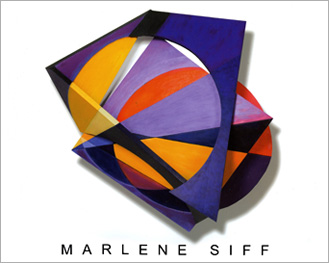
Essay by Edward Lucie Smith
Marlene Siff Solo Exhibition, 2004
Walter Wickiser Gallery, New York, NY
www.walterwickisergallery.com
Marlene Siff is a visionary artist, who sees her work as a means of giving form to states of mind. She uses an intricate interplay of geometric shapes in order to achieve this end.
The desire to represent inner harmonies, without resort to conventional figuration is, of course, something with its roots in the earliest, most heroic years of the Modern Movement in art. The Italian Futurist went some way along this road, but the final leap was the work of artists of Russian origin - first Kandinsky's little treatise "On the Spiritual in Art" remains a textbook for artists to this day, and then of the group clustered around Malevich, the leader of the Suprematist Movement.
The interesting thing was that while Malevich's work, which was deeply involved with the idea of spirituality, in a way that was traditionally Russian, and reached back in time to the work of great late medieval icon painters such as Andrei Rublev, he was opposed by a group of Russian Constructivists, who used the same abstract vocabulary for what they declared were purely material ends. Among the leading Constructivists were two sculptors, the brothers Antoine Pevsner and Naum Gabo, whose use of interlocking geometric shapes has much in common with Marlene Siff's three-dimensional work.
Essentially what the Russian avant-garde of the immediately pre-Revolutionary period brought into focus was the conflict between the social and the personal that has continued to haunt experimental artists ever since. For example, the declared intention of Siff's work is close to statements made by the leading American Abstract Expressionists, and especially by Rothko (an artist who, it must be remembered, was of Russian origin). Rothko once said that he wanted spectators to be moved to tears by his work, without knowing why. In other words what he tried to offer was a spiritual experience that did not make reference to any particular faith.
The tone of much Abstract Expressionist painting is notoriously tragic, imbued with a melancholy sense of destiny, though, paradoxically, representing American culture at its most exalted and triumphant moment. This is not Marlene Siff's intention. She aims, rather, to offer forms that make the world seem more harmonious, that gently bring us into alignment with natural rhythms.
One way in which her work looks back to Italian Futurism, rather than to the Russian art-movements of the same epoch is through its interest in what is physically dynamic. Her reliefs and sculptures often suggest that the forms we are looking at are actually in motion.
There is one artist of the High Modernist period who does much the same thing, while banishing the lingering traces of figuration that one finds in Futurist work. This is the long-lived Sonia Delaunay-Terck, a Russian married to one of the leading members of the Parisian avant-garde, Robert Delaunay.
One of the ways in which the Delaunays differed from their rival and contemporaries was that their work expressed a radiant faith in the future that remained unshaken by world events. I think Marlene Siff's work offers an equivalent, and now rare, optimism about human possibility, and this is one of the things that gives it its special flavor.
Edward Lucie Smith
Edward Lucie-Smith is best known as a writer of books on contemporary art. His titles include Movements in Art Since 1945, Art Today and Art Tomorrow. He is also an exhibition curator, poet and internationally exhibited photographer.
|